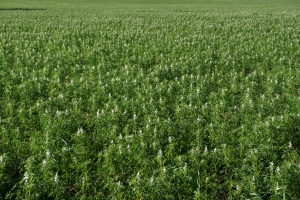Review investigates control options for blue lupin
Author: media@grdc.com.au | Date: 19 May 2020

Blue lupin may have brightly coloured flowers, but its cerulean blossoms hold no appeal for many growers of grain lupin crops in Western Australia.
Also known as sandplain lupin, blue lupin (Lupinus cosentinii) has hard seeds which persist in the soil and germinate to compete with narrow-leaf and albus lupin crops, particularly in the Geraldton port zone.
Although still used for soil improvement and sheep feed in some areas where there are infertile deep sands, most growers now consider it a weed and no registered herbicides will selectively control it in grain lupin crops.
The area of production of grain lupin crops averages 550,000 hectares per year in Australia and the crop is uniquely well suited to the deep, acid sandy soils that occur over large areas of WA and which are particularly common in the State’s northern grainbelt.
Blue lupin is a particular focus of a new Grains Research and Development Corporation (GRDC) investment reviewing whether there are any possible chemical options for the management of broadleaf weeds of narrow-leaf and albus lupin.

GRDC crop protection manager – west, Georgia Megirian, said the review, being conducted this year by Independent Consultants Australia Network (ICAN), would inform any potential future research, development and extension (RD&E) investments into broadleaf weed management in lupin.
“Chemical use in-crop and maximum residue levels (MRLs) are increasingly under scrutiny in our industry, so freedom to operate and market access are crucial considerations in any herbicide research,” she said.
“This review is a critical step in seeking additional solutions for broadleaf weed control in grain lupin, as it will potentially identify particular chemistries that have registrant support and any data requirements necessary for regulatory approval of use.
“It will help to prevent the scenario where costly, and potentially unusable, bulk screenings of herbicides are undertaken in field trials. Rather, any necessary screenings in the field can be focussed and more likely to produce a scenario where growers can benefit from them.”
Ms Megirian said chemical control options for blue lupin in grain lupin crops were not easy to identify due to the similarity between these species.
“The feasibility of other management strategies for blue lupin, including non-chemical options, are continuing to be explored,” she said.
Contact Details
For Interviews
Georgia Megirian, GRDC crop protection manager – west
0439 575 900
georgia.megirian@grdc.com.au
Contact
media@grdc.com.au – West
0427 189 827
media@grdc.com.au
GRDC Project Code: ICN2004-004CAX,
Was this page helpful?
YOUR FEEDBACK
